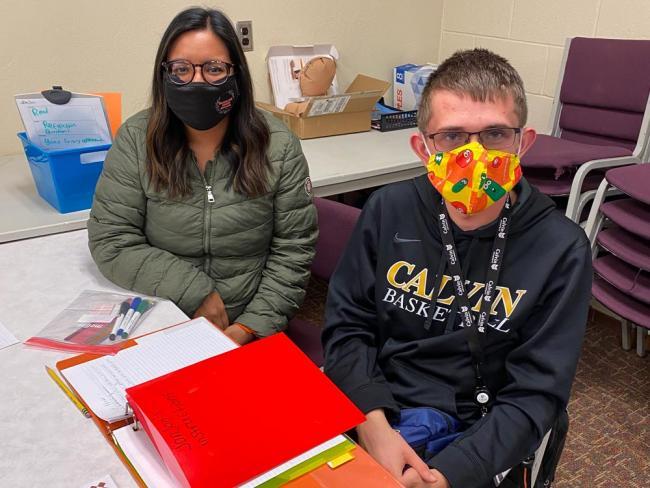A School News Network feature: Calvin University student JonJon Conflitti enjoys his classes but has a hard time focusing on assignments. As a person with autism, he struggles with slowing down and keeping his work organized.
He’s getting help from Mandy Enos, a second-year student in Grand Rapids Community College’s Occupational Therapy Assistant program. She recently met with Conflitti to discuss his needs and use her knowledge and background to help come up with solutions to his focusing issues.
“I created a homework checklist with Calvin’s Knight logo on it and put them in clear sleeves so he could write on them and then erase,” Enos said. “He was so excited while working with me and was happy to have someone helping him better complete his assignments.”
Conflitti currently takes a mix of courses through Calvin and the Ready For Life Academy with the goal of graduating, getting a full-time job and living independently. With a presence at Hope College, Calvin University and Ferris State University, Ready for Life helps provide post-secondary educational experiences for college-aged individuals diagnosed with intellectual disabilities.
“I worked with Mandy, so I could learn to slow down the process of doing my work and going back to check and proofread my work,” Conflitti said. “It was so good and now I have a homework checklist that I can write on and erase and I’m focusing a lot better.”
A Creative Solution
The new partnership between the Occupational Therapy Assistant program and Ready for Life students formed during the pandemic as a way to help students who fell behind on their requirements. In March, GRCC pulled second-year students from their fieldwork, which is required for completing the program and becoming a certified occupational therapy assistant, said GRCC Professor Robin Pegg, the program’s academic fieldwork coordinator.
“By the time hospitals and our other partners began taking students back in the fall, everyone was trying to finish their second year,” Pegg said. “I went to my boss and said, ‘Houston, we have a problem.’”
“We got creative this semester with a great partnership,” she said. “My students pair up with a real person and real problem to analyze and come up with a solution for each person.”
Pegg connected with longtime colleague Emily Perton, executive director of the Ready for Life Academy. The two put their heads together and came up with a plan to benefit both GRCC and RFL students.
“Robin’s students brought something new to the table we didn’t think about before,” Perton said. “The Ready for Life Academy students love interacting with college students, collaborating on their projects and building friendships.”
‘Students Learn, Community Benefits’
For Pegg, key pieces to the partnership are the emphasis on collaboration and the dual benefits received by both organizations.
“The college came up with the saying, ‘students learn, community benefits,’” Pegg said. “Working alongside RFL has been an all around win for everyone.”
She divided her class of 24 students into groups of eight and paired them with RFL students. To prepare, GRCC students watched videos of their clients doing a task they struggled with and met with them one-on-one to gain a better understanding of their needs.
“My students have one month to communicate and meet with their student, make a plan, run it by their student’s caregiver and myself, make any adjustments to their proposed solution and then present it to their client,” Pegg explained.
GRCC student Abigail Cummings was excited to work with her client and apply the skills she learned in the classroom to real life.
“My client’s goal is to professionally clean homes, but she experiences difficulties with sequencing and remembering the steps of cleaning things,” Cummings said. “I created stickers and visuals to put on her toilet to help her remember all the sections to clean and in what order.”
She gave the plan to her client’s caregiver, helped make adjustments, Cummings said. “Open communication is a big thing; you have to make sure you’re looking at all aspects of the person and their abilities.”
Pegg is impressed with the creative accommodations the students came up with. “From vacuuming to organization skills to carrying a bowl of soup, the problems the students have dealt with have been simple to complex,” Pegg said. “It’s been fascinating for the students to understand that something as simple as getting something out of the oven can literally inhibit someone’s independence.”
Perton is excited about how much the students are learning from their experiences working with real clients.
“This isn’t just a career; it’s life-changing for people,” Perton said. “It’s easy for students to get caught up just learning the material. This partnership shows them they’re going to make a real difference in someone’s life.”
Keeping Connections Going
Pegg is optimistic about the long-term benefits of the partnership. “The gains are huge and it helps reduce the workload on our community partners,” she said. “We now have some structure and control around ensuring the students share a similar experience and gain the same sense of accomplishment.”
Due to the pandemic, both GRCC and the RFL programs are facing limitations and students are feeling isolated.
“This partnership opened a door of new opportunities to get excited about,” Perton said. “Our students and clients are used to someone being with them at all times, but this experience provides an opportunity to communicate and advocate for themselves without parents or guardians.”
Real-world problems allow the GRCC students to get creative with their solutions and learn lifelong problem-solving skills.
“Some students have just blossomed and it’s been amazing getting them to use their creativity on their own projects,” Pegg said. “The growth zone is the icky, unsettling place and students all have to learn to grow through it. This partnership encourages them to learn and grow, while benefiting another human being.”
This story was reported and photographed by Alexis Stark of the School News Network.
